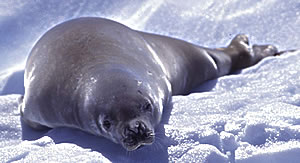Crabeater Seals

Common Name: Crabeater Seals
Scientific Name: Lobodon carcinophaga
Description
Crabeater seals are the most numerous of the world's seals. There are millions of crabeater seals. After the pups are born, a male will join and defend the female, waiting for his chance to breed. Crabeater seals can be found in large numbers but are more likely observed alone or in small groups. A crabeater seal usually feeds at night, will spend 8-10 hours feeding, and will make over 100 dives.
Size
Males and females are similar in size, reaching lengths of 2.5m and weights of 400kg.
Diet
Crabeater seals have one main food item, krill, which is an abundant shrimp-like crustacean that is found all around Antarctica.
Behaviour
They are capable of diving to depths of up to 250m, but usually feed within the upper 20m of the water column.
Breeding
They breed on the ice from late September to early November. Females give birth to a single pup which is weaned 3-4 weeks after birth. During this time the female spends the entire time on the ice with the pup.
During the breeding season the female and pup are usually accompanied by a male which mates with the female when she comes into oestrous. The male plays no part in bringing up the pup, and the group disbands once the pup is weaned.
Moulting
Moulting occurs in January and February. Seals spend most of their time on the ice when moulting.
Crabeater Seals Live
Crabeater seals inhabit the pack ice zone surrounding Antarctica. On rare occasions they may be found on the South African coasts, South American coasts, Australian and New Zealand coasts, and the islands that surround Antarctica.
Population
Although it was once thought that there may be over 15 million crabeater seals. There is currently no reliable estimate of the abundance of crabeater seals. An international group of scientists is currently collaborating to decide a good population estimate.
Crabeater Seal Life
Crabeater seals have been known to live for forty years.
Threats
Leopard seals are a major predator of crabeater seals, particularly of young pups. Most adult crabeater seals have large scars as a result of unsuccessful predation by leopard seals when they were younger.
Move
Crabeater seals can move large distances through the pack-ice, due to both active movement and passive movement on drifting ice floes. They generally move southwards in spring, and northwards in autumn, with the seasonal contraction and expansion of the pack-ice.
Identify Crabeater Seals
Crabeater seals will weigh up to 500 pounds with the female being larger. They will reach 7 feet in length. At the end of summer they are almost white. The teeth of crabeater seals may be the most specialized of any carnivore. The crabeater seal may be the fastest of all the pinnipeds on ice, faster than a man can run.
 Deep Sea Crabs
Deep Sea Crabs